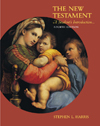|
 |  The New Testament, 4/e Stephen Harris,
California State University - Sacramento
The Judeo-Christian Bible and Subsequent History
Outline
I. The evolution of the Hebrew Bible and the Christian Greek scriptures - The evolution of the Hebrew biblical canon
- Completed by late first century C.E.
- Influenced by rabbis at Jamnia
- Hebrew biblical canon ends at 1 Chronicles
- Christian New Testament begins at Matthew, ends at Revelation
- Christians see their canon as fulfillment of Old Testament covenant promises
- New Testament canon reflects dominance of the figure of Jesus Christ
- Place of Revelation in canon reflects impact of apocalypticism in early Christian thought
- Books of 1 Clement and 2 Peter deal with delay of the Parousia
|
|
|



 2002 McGraw-Hill Higher Education
2002 McGraw-Hill Higher Education